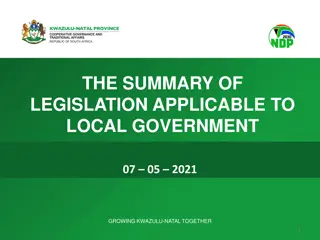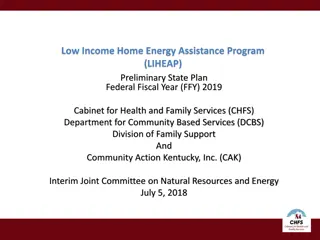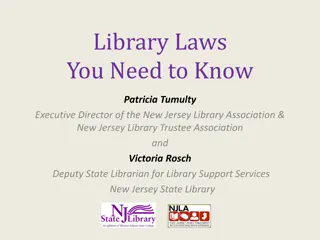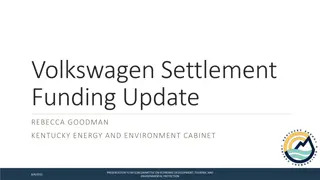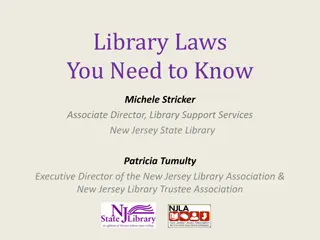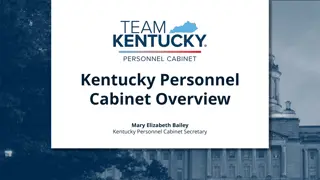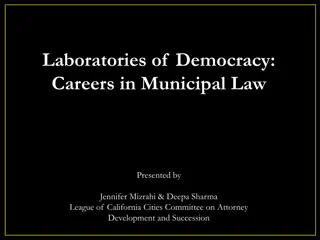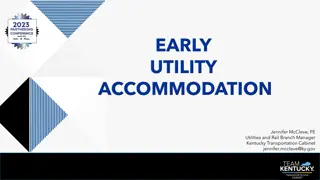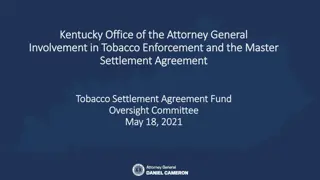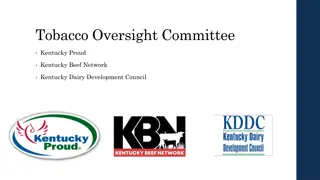Municipal Annexation Guidelines in Kentucky
Understanding the regulations governing municipal annexations in Kentucky, including the requirements for territory contiguity, urban development suitability, and limitations on incorporating lands within existing cities. Corridor annexations are discussed, outlining the criteria and responsibilities involved.
Download Presentation

Please find below an Image/Link to download the presentation.
The content on the website is provided AS IS for your information and personal use only. It may not be sold, licensed, or shared on other websites without obtaining consent from the author.If you encounter any issues during the download, it is possible that the publisher has removed the file from their server.
You are allowed to download the files provided on this website for personal or commercial use, subject to the condition that they are used lawfully. All files are the property of their respective owners.
The content on the website is provided AS IS for your information and personal use only. It may not be sold, licensed, or shared on other websites without obtaining consent from the author.
E N D
Presentation Transcript
Municipal Annexations KRS 81A.005 - KRS 81A.520
Consolidated Local Government KRS 67C.111 Any proposed annexation by a city in that county shall first receive the approval of the legislative council of the consolidated local government prior to the city proceeding with annexation. After July 15, 2024, - Change in law allowing a petition by sixty-six percent (66%) or more of the qualified voters of the area proposed to be annexed to allow annexation.
1. The territory proposed to be annexed must be adjacent or contiguous to the city limits [KRS 81.A410(1)(a)]
1a. Corridor Annexation is the annexation of thin strips of land such which is between the territories. as highways only the link
Corridor Annexation In general, it is disfavored, but courts support corridor annexation IF there is a tangible Municipal Purpose. Municipal Purpose cannot be just contiguity, but instead the corridor serves a concrete and tangible municipal purpose existing at the time the annexation (Generally, it is where water mains and/or sewer lines or sewer lift stations or other utilities exist at the time of annexation.) will is sought.
Corridor Annexation If the corridor annexation on a road, then it becomes a city road, and the city is responsible for upkeep. If the City annexes rights of way next to the road, but does not include the road, then the city is not responsible for the roads as they remain within the County limits.
2. The annexed must be urban in character or suitable for urban development without unreasonable delay [KRS 81A.410(1)(b)] territory proposed to be
3. The territory proposed to be annexed may NOT include lands that lie within the boundaries of another incorporated city. [KRS 81A.410(2)]
4. Any land within an agricultural district formed pursuant to KRS 262.850 - Agricultural District and Conservation Act - CANNOT be annexed.
5. General Rule - No part of the territory proposed to be annexed may lie in another county (limited exception in KRS 81A.415 which provides a limited option for cities already located within 2 counties to annex territory located in a third county that contains the city s utility infrastructure.)
1. Consensual Most common type of annexation 97% of all the annexation in the State of Kentucky for the last 3 years were consensual. 2 Pathways to Annexation 2. Non-Consensual Uncommon in Kentucky. Process to annexation requires more steps in order to protect the property owners and residents in the area being annexed.
Consensual Annexation Steps The city may immediately enact an ordinance annexing territory into the city if it obtains the written consent of each owner of real property within the territory proposed to be annexed. Elements of the consensual annexation: The consent must be in writing. The city must obtain the written consent of each property owner within the territory.
Nonconsensual Annexation Steps Have the first reading of an intent to annex ordinance Send a notice of the second reading of the intent to annex ordinance to all real property owners within the territory proposed to be annexed within requisite statutory time requirements. Have the second reading and passage of the intent to annex ordinance. proper individuals and entities.
Nonconsensual Annexation Steps Publication of the intent to annex ordinance and notice of right to petition to place the question of annexation on the ballot within 60 days. Publish the notice of right to petition again within 7-21 days prior to due date. If no petition is received, enact an annexation ordinance. Send notice of the annexation to the proper individuals and entities.
Non-Consensual Annexation Petition Received When a valid petition (signed by either 50% of resident voters within the proposed annexed territory or 50% of the real property owners in the proposed annexed territory) has been received by the Mayor, it is placed on the next regular election by County Clerk. If 55% of those voting vote to oppose annexation, then the annexation is defeated, and no portion of the proposed annexed property can be annexed for five (5) years. If not, then the City goes forward and passes an annexation ordinance.
Final Steps Send notice of the annexation to the proper individuals and entities. The city must deliver a copy of the annexation ordinance, map, and list of properties with name and address for each property owner to the county clerk within 60 days of the annexation. The city must send the ordinance and a map prepared by land surveyor to the Secretary of States office. The City Clerk must send a map with new boundaries to the Kentucky Revenue Cabinet The city must send the map to all franchise taxpayers.
Industrial Annexation Non-Consensual KRS 81A.510 provides the method for non-consensual annexation of territory that contains an industrial plant or plant(s) which require that the territory being annexed contained registered voters in numbers equal to or greater than 50% of the average number of employees of the industry in the preceding calendar year.
Other Relevant Statutes KRS 81A.427 imposes additional requirements on a city annexing territory containing the utility infrastructure owned by another city. KRS 81A.490 provides that the rights of utilities in an area annexed by a city are expressly preserved.
Temporary Annexation Procedures Senate Bill 141 Beginning on March 1, 2023, cities will only be permitted to complete annexation that were started but not completed prior to March 29, 2023 and can only initiate new annexation if it meets the following criteria: An opportunity for substantial economic development would be impeded if a parcel of land is not annexed. An annexation of a parcel would directly facility the delivery of new or substantially improved services that cannot be provided by the city in the absence of the annexation or the lack of annexation will result in the substantial loss of service. If annexation was started on or after March 1, 2023, and a contract associated with the annexation let prior to March 29, 2023 would be voided by the provisions of SB 141
Temporary Annexation Procedures Senate Bill 141 The property owner has requested the annexation of property that is contiguous to the existing city boundary and the city provides written notice to the fiscal court at least 45 days prior to enacting the final ordinance annexing the property; The fiscal court has concurred in the annexation; or
Temporary Annexation Procedures Senate Bill 141 The provision of Senate Bill 141 would void, alter, or otherwise impede the continuation of any provision of an interlocal agreement executed by the county and one or more cities within the county involving occupational license fees or insurance premium taxes. When annexation is required in order to maintain ongoing services provided by a city to a school, no city, prior to July 1, 2024, may initiate or complete an annexation of an area that includes any property owned by that school district unless requested by the school district and concurred with by the fiscal court of the county.
Standing Standing to Challenge Annexations has been extended to permit those that are harmed to contest the legality of the annexation, including adjoining property owners. Except through Senate Bill 141 that allow standing for counties to oppose annexation, counties do not have a statutory right to challenge.
Zoning Options The city may wait to zone the newly annexed territory using normal procedures provided in KRS Chapter 100 after the annexation is complete. The city may proceed to propose zoning between the intent to annex ordinance and the annexation ordinance by following the procedures outlined in KRS 100.209
Taxing Requirements After the annexation, the burden of taxation must be uniform throughout the city. This means the city must assume any liabilities attached to the annexed territory and the annexed territory must assume its fair share of the tax burden. [KRS 81A.450]
REVENUE OPTIONS FOR CITIES AND COUNTIES
MAIN REVENUE OPTIONS FOR CITY & COUNTY Property Taxes (Real, Personal & Motor Vehicles) Occupational License Taxes (Payroll, Net Profits or Gross Receipts) Insurance Premium Taxes
OTHER REVENUE OPTIONS BY BOTH ENTITIES Bank Franchise/Local Deposits Transient Room Tax pass through tax that funds Tourism Commissions Alcohol Regulatory fees (in general up to 5%) former 3rd & 4th class cities, city under 20,000 and counties where cities can collect it. 911 Fees User Fees





